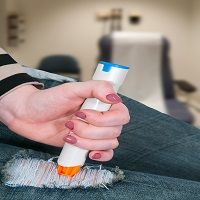Article
New Methods to Help Spot Severe Anaphylaxis?
Author(s):
New research finds that flushing and dyspnea may help physicians spot unusually severe cases of anaphylaxis, cases that will put patients at particular risk and require more than a single dose of epinephrine.

New research finds that flushing and dyspnea may help physicians spot unusually severe cases of anaphylaxis, cases that will put patients at particular risk and require more than a single dose of epinephrine.
A team from the Mayo Clinic reviewed nearly 6 years of data and found records for 582 patients who received emergency department care for anaphylaxis. Only 45 of those patients (8%) required more than one epinephrine injection, but an examination of both their emergency department records and medical histories uncovered some significant correlations.
Multivariable analysis found that the need for two or more doses of epinephrine was associated with prior anaphylaxis (odds ratio [OR], 2.5; 95% confidence interval [CI], 1.3-4.7; P=0.005).
The researchers also uncovered two other correlations that might prove more valuable to emergency department workers — correlations to symptoms that can be observed on the spot.
Flushing or diaphoresis was associated with a need for multiple injections (OR, 2.4; 95% CI, 1.3-4.5; P=0.007). There was also a weaker, though still significant, association with dyspnea (OR, 2.2; 95% CI, 1.0-5.0; P=0.046).
Although it was rare for patients to require more than 1 dose of epinephrine after arriving at the emergency department, it is important for caregivers to identify such cases early and treat them quickly. Reactions that fail to respond in full to the initial injection pose a comparatively high risk of death and other poor outcomes.
For example, the new Mayo study found that patients who received more than one injection were more likely than other anaphylaxis patients to be admitted to the general practice floor (OR, 2.8; 95% CI, 1.1-7.2; P=0.03) or the intensive care unit (OR, 7.6; 95% CI, 3.7-15.6; P< 0.001).
The researchers noted several limitations in their work, including its retrospective nature and the reasonably small sample of patients who needed more than one epinephrine injection. They called for further research but urged emergency department physicians to consider their findings.
“Patients with a history of anaphylaxis, flushing or diaphoresis, or dyspnea may require multiple doses of epinephrine to treat anaphylactic reactions,” the study authors wrote in the Journal of Allergy and Clinical Immunology: In Practice. “Patients who require more than one dose are more likely to be admitted to the hospital, thus increasing health care resource utilization.”
Decisions about emergency department epinephrine use can be complicated by uncertainty about whether patients have already injected themselves.
Allergy treatment guidelines call for many patients to carry and use their own auto-injectors. Previous research, however, has found that only a small number of patients manage to treat their own reactions properly before they receive medical care.
It was discovered that most people don’t carry epinephrine when anaphylaxis strikes, either because they’d never been diagnosed with allergies or they’d failed to keep their medication on hand.
Even patients who carried epinephrine and tried to use it often fail to administer it properly. A number of studies have shown that most such patients misuse their auto-injectors and that many have no chance of delivering epinephrine to themselves because the needles of such devices are not long enough to penetrate the layer of fat surrounding their thighs.
Emergency room physicians, therefore, should not assume that people who believe they have given themselves one dose epinephrine have actually managed to do so.





